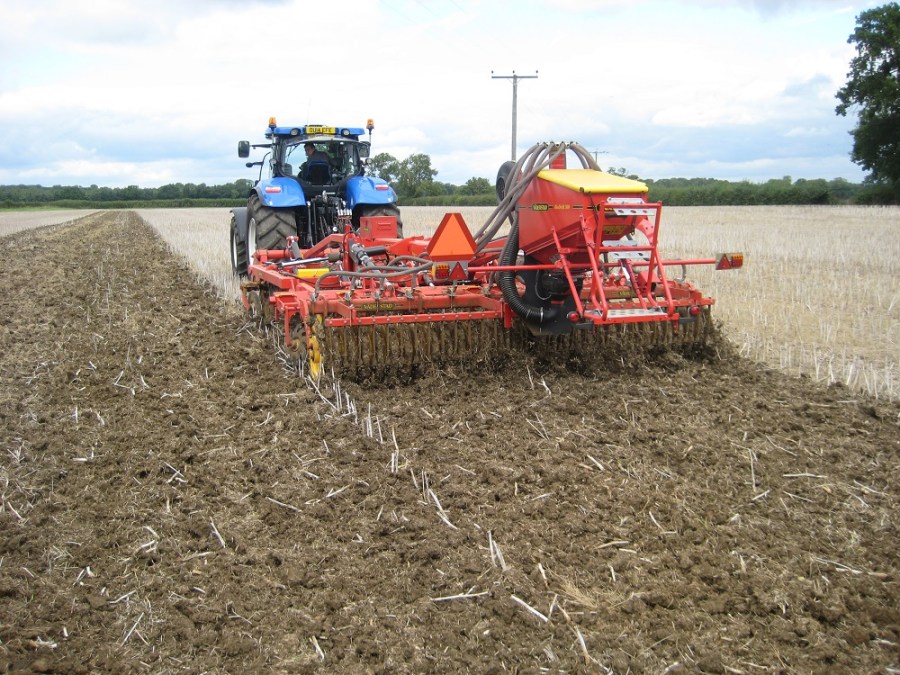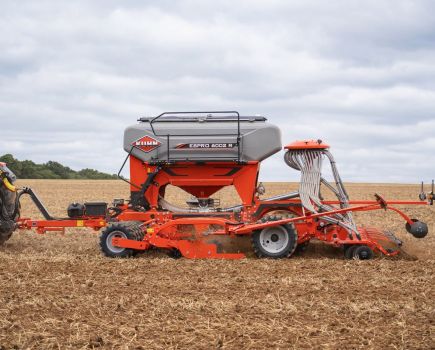An establishment trial in Bucks aims to shed light on how blackgrass behaves in direct drilling and min till regimes, with catch and cover crops also under scrutiny. CPM reports on results so far.
Blackgrass control in winter cereals is highly dependent on Liberator, so cultivation needs to produce conditions that help it work effectively.
By Rob Jones
When Bucks grower Mike Markham made the switch recently to direct establishment with a Cross-Slot drill, he was aware the transition is about more than just a new drill. So he’s taking full advantage of a Bayer, Agrii and Väderstad trial on his land to learn more about the relationship between establishment and weed control.
B Markham and Son farms 1210ha in conjunction with Roger Brown (Mixbury) and Owen Farms (Westbury) across
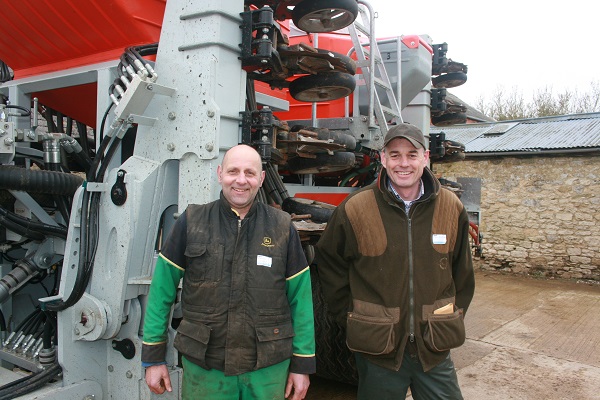
MIke Markham and Kevin Willis with the Cross-Slot drill (use with story):
Mike Markham’s (right) Cross-Slot drill, operated by Kevin Willis is pitched in the on-farm trial against a Väderstad TopDown and Rapid system.
a wide range of soil types from limestone brash to heavy clay. In 2014, they started looking into options for a new drill and tested 12 different machines before making the decision. They wanted something that could easily operate in all soil types and establish catch crops and cover crops straight after harvest.
Standard design
“The coulter unit on the Cross-Slot is a standard design from Massey University, New Zealand which has been used on various machines all around the world,” says Mike Markham. “We liked this versatility because it means it could work on all soil types on the farms.”
The drill is used to sow catch crops straight after harvest and the late-sown wheat that follows. So far, Mike has used black oat and tillage radish for catch crops that help maintain soil structure to allow late Oct drilling on heavier land.
Direct establishment in Aug presents a challenge because the ground is usually fairly hard, he said. This is overcome by the size of the drill which, coupled with the tractor and liquid fertiliser tank, comes in at a considerable 30t, so it has the momentum to travel through harder soils.
But what does direct establishment mean for blackgrass control on farm?
According to Ben Giles of Bayer there isn’t a simple answer to this question but the on-farm trial should help. “The conventional wisdom is that the less soil you move, the less germination of blackgrass you get, but there are other things to consider such as whether the wide row spacing from the Cross-Slot may give more space for blackgrass to germinate and develop,”
No effect on blackgrass
“A vigorous catch crop can limit the growth of blackgrass in the gap between harvest and drilling, but by doing this, does it mean more blackgrass will germinate later or will blackgrass seeds perish on the surface?” So far, Mike Markham hasn’t seen any evidence of an effect on blackgrass numbers: positive or negative.
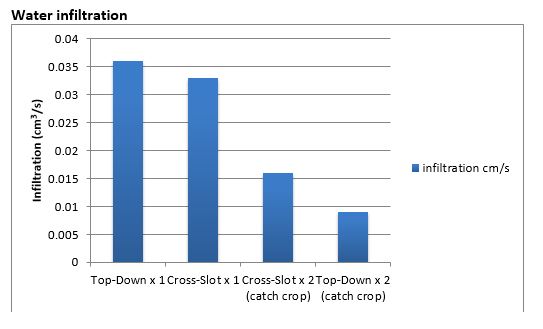
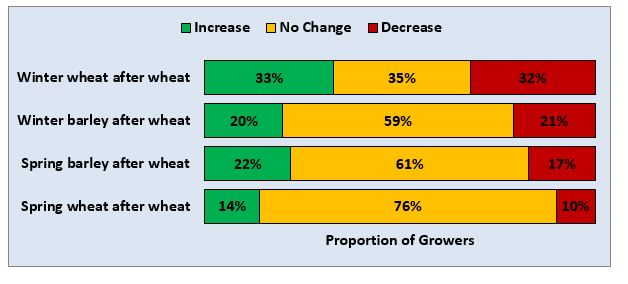
The other point of concern is trash – direct establishment into stubble after a catch crop could leave trash on the surface that may act as a barrier to residual herbicides such as Liberator (flufenacet+ diflufenican) which are vital for blackgrass control.
However, Mike Markham is happy with the performance so far. “We’ve had no problems with residuals to date, we apply glyphosate and the residuals together after drilling. It’s surprising how quickly the cover crop breaks down after glyphosate plus the drill breaks it up a lot too.”
Establishment comparison
The trial compares direct drilling to soil-moving establishment using a Väderstad TopDown followed by a Rapid drill – both methods are being trialled with and without a catch crop of black oats and oil radish. Mid-way through the season, there are no final results for blackgrass numbers yet, but there are some useful pointers, says Andrew Richards of Agrii.
“Blackgrass control in winter cereals is highly dependent on Liberator, so cultivation needs to produce conditions that help it work effectively at pre and peri-emergence,” he insists. Later drilling can be advantageous because lower soil temperatures allow herbicides to last longer and there’s usually adequate moisture for the active to become soil mobile and reach the germination zone.
At present, the chief differences between plots appear to be explained by the effect of the primary cultivation, specifically the number of passes and timing. In untreated plots, the crop established with one pass of the TopDown has 94 blackgrass plants/m² whereas the Cross-Slot without a cover crop has over 120. Within the herbicide trial there’s no evidence yet of an interaction between the active and establishment method – pre-ems have performed well with 80% control and above.
Due to the vagaries of planning and running a trial, catch crops weren’t sown until late Aug (Cross-Slot) and early Sept (TopDown BioDrill). Consequently, they established very poorly and were effectively an additional and unnecessary cultivation rather than an aid to weed control and soil quality as planned.
The land that had two passes of the TopDown and the unsuccessful catch crop is in visibly poorer and wetter condition than the other plots. Results from an infiltrometer test back this up with water infiltration rates of less than 0.01cm3/s compared with 0.036cm3/s with one pass of the TopDown (see chart on pxx). Based on current plant counts, this land also had the highest level of blackgrass in untreated plots.
“In this area, the discs on the cultivator effectively smeared the soil creating an impermeable barrier because it was cultivated when the ground was a little too wet,” says Ben Giles. This is shown by the penetrometer readings (see chart on pxx) where the resistance doubles at 40cm in this area.
In the move to direct establishment, it’s important not to overlook that cultivation mineralises N making it available to the crop, notes Andrew Richards. Direct drilling in late Oct leaves crops short of nitrogen with development hampered right into spring. In the trial, crops established with the Väderstad system were well tillered by early March whereas the direct-drilled crops were still languishing at GS15–19.
Later drilling
Some of this difference is explained by the later drilling date for the Cross-Slot plots (28 Oct versus 20 Oct), but the lack of N mineralisation is borne out by the N-Min tests which show that there’s still much more potentially available nitrogen left in the direct-drilled land.
“Direct establishment in late Oct is indeed a challenge because of N mineralisation, we’ve managed to get a derogation for one farmer to use a small amount of starter N and intend to see if we can do some detailed work to get a wider derogation,” says Andrew Richards. “But we also need to answer the question of whether we can drill earlier and still get weed control because we’re moving almost no soil.”
Ben Giles agrees that this is another area with more questions than answers at this stage. “The interesting thing is that the wheat is much more developed in the plots that had two passes with the TopDown, despite it being so wet, than on the Cross-Slot land, even though this has much better soil conditions.
“We’re going to keep an eye on how it plays out over the rest of the season. For weed control, the concern is that blackgrass will tiller extensively in the direct-drilled crops due to a lack of crop competition.
“On the other hand, relatively benign growing conditions would mean that the TopDown x2 land could still produce a good yield, but any sort of dry spell could put it under pressure if the crop’s root system is poorly developed because of compaction.”
Trial details
| TopDown fb Rapid
no catch crop |
TopDown x2
Rapid with catch crop |
Cross slot
no catch crop |
Cross slot x2
with catch crop |
|
| 1st operation | 04/09 | 04/09 | 28/08 | |
| 2nd operation | 15/10 | |||
| Drill date (JB Diego) | 20/10 | 20/10 | 28/10 | 28/10 |

